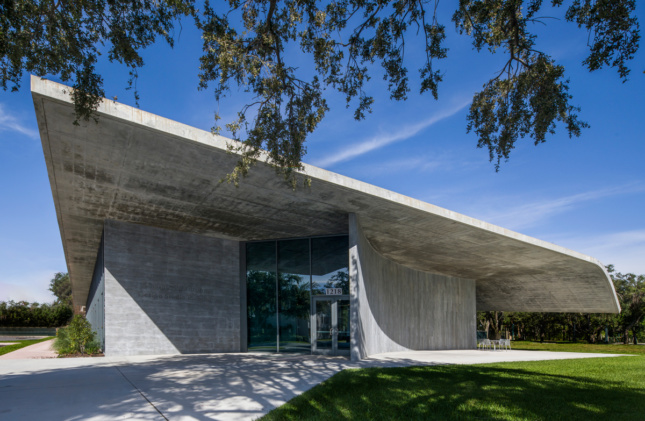
The University of Miami School of Architecture has added a concrete home for design research and collaboration to the institution’s Coral Gables campus. Designed by Arquitectonica, the 20,000-square-foot Thomas P. Murphy Design Studio features a new digital fabrication lab and ample collaborative space. It’s the first construction completed on the site in the past decade.
The project broke ground in October 2015 and opened to students this fall semester. Located on the edge of the campus, the stark structure stands out among a swath of palm trees and nearby boxy buildings. Though it may look dramatic, its design centers on a simple geometry, according to Arquitectonica principal Raymond Fort. It’s a single, oversized shed featuring two main materials and a southern sloping edge that blocks harsh sunlight while aligning the building with Southern Florida’s modernist architectural style.
“Even though the forms appear to be expressive, we wanted to keep it as simple as we could with the components of the architecture visible,” he said. “The 25-foot cantilever curves at the bottom to address the portico of the nearby Perez Architecture Center, designed by Leon Krier, which is the center of the architecture campus.”
From the exterior, Arquitectonica’s dynamic design studio looks sleek and shaded. But inside, loads of daylight seep into the structure through glass window walls, and an exposed ceiling showcasing the building’s mechanical elements gives away its structure. The open plan studio is designed around a 25-foot square module that allows up to 120 students to rearrange workstations as they see fit. For private meetings, juried critiques, and seminars, students can utilize scattered cubes with glass walls or curtains running through the center of the nave-like space.
Showing off the structure’s core through a transparent layout was a deliberate design decision—one that was lauded by both the students and the university administration. Previously, students were confined to cramped studio space within the old, Marion Manly–designed buildings, which were originally built to house returning veterans from World War II. Arquitectonica envisioned a modern and industrial open plan for the Thomas P. Murphy Design Studio to directly fix the spatial constraints architecture students faced within the old facilities. While each of the school’s buildings features one-of-a-kind designs, none brought together studio space under a single roof.
“It complements the school’s constellation of buildings that constitute a campus-within-the-campus,” said Dean Rodolphe el-Khoury in a statement. “The vast studio space designed to enhance co-creation and the digital fabrication lab, among several other features, are welcome additions to our beloved historic and award-winning facilities.”
Not only was the structure designed to elevate the students’ daily experience, it was built to serve as a teaching tool by showcasing the basics of modern design, construction, and sustainability. It can operate during the day without any artificial light thanks to the 18-foot-high hurricane resistant glass panels and remain cool at night due to the large envelope of thin concrete covering the interior. These materials ensure the project will remain durable for years to come.
An official dedication ceremony for the Thomas P. Murphy Design Studio, named after the late father of Coastal Construction CEO and President Tom Murphy, Jr., will be held on November 29.